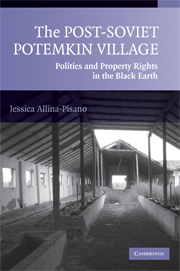Book contents
- Frontmatter
- Contents
- List of Maps, Illustrations, and Tables
- Acknowledgments
- Note on Transliteration
- Note on Sources and Methodology
- Glossary
- Two regions of the Black Earth, Voronezh and Kharkiv oblasti, 1991–present
- Voronezh oblast' in the twenty-first century
- Kharkiv oblast' in the twenty-first century
- The Post-Soviet Potemkin Village
- Introduction: Land Reform in Post-Communist Europe
- 1 Things Fall Apart
- 2 Keeping the Collectives
- 3 The Social Origins of Private Farmers
- 4 A Return to Regulation
- 5 The Politics of Payment
- 6 The Facade
- Conclusion: Rural Proletarians in the Potemkin Village
- Index
Introduction: Land Reform in Post-Communist Europe
Published online by Cambridge University Press: 27 July 2009
- Frontmatter
- Contents
- List of Maps, Illustrations, and Tables
- Acknowledgments
- Note on Transliteration
- Note on Sources and Methodology
- Glossary
- Two regions of the Black Earth, Voronezh and Kharkiv oblasti, 1991–present
- Voronezh oblast' in the twenty-first century
- Kharkiv oblast' in the twenty-first century
- The Post-Soviet Potemkin Village
- Introduction: Land Reform in Post-Communist Europe
- 1 Things Fall Apart
- 2 Keeping the Collectives
- 3 The Social Origins of Private Farmers
- 4 A Return to Regulation
- 5 The Politics of Payment
- 6 The Facade
- Conclusion: Rural Proletarians in the Potemkin Village
- Index
Summary
In December 1991, as the flag of the Soviet Union flew its last days over the Kremlin, a small crowd armed with crutches and wheelchair wheels stormed the regional state administration building in an eastern Ukrainian city. The city, Kharkiv, lies fifty miles from the Russian border. The protesters were a group of senior citizens and disabled people from the Saltivka housing development in Moskovsky district, an area of the city named for its location on the road to the Soviet metropolis. The group had gathered to demand land for garden plots.
The protesters had specific land in mind. The land lay at the eastern edge of the city, bordering the Saltivka housing development to the west and the fields of one of the most successful agricultural collectives in the region to the east. That farm, named Ukrainka, was among the biggest dairy producers in the area. Food supplies in city markets, however, had become unpredictable and expensive. Residents of Saltivka wanted land to grow produce for themselves and their families.
In response, the Kharkiv district executive committee ordered that Ukrainka relinquish nearly 300 hectares of land for garden plots, in addition to 75 hectares already alienated for that purpose the previous spring. Members of the Ukrainka collective objected to the proposed plan, arguing that the proximity of the housing development already caused problems for the farm. Residents of the development walked their dogs in the fields, trampling down seedlings and ruining crops.
- Type
- Chapter
- Information
- The Post-Soviet Potemkin VillagePolitics and Property Rights in the Black Earth, pp. 1 - 27Publisher: Cambridge University PressPrint publication year: 2007



